KTE resources
Based on six years of learning, the ELPH team has produced a collection of knowledge translation and exchange (KTE) resources to inform, guide and inspire health equity action in public health to influence reorientation of the health system towards health equity. These resources are provided within a broader call to action to support an organizational culture that values health equity and social justice. We recognize that health systems are complex and that organizational change takes time. These resources are meant to help move complex health systems closer to the foundational goal of closing the health inequities gap through reorienting health systems toward health equity.
Reorienting Health Systems Towards Health Equity: The Systems Health Equity Lens
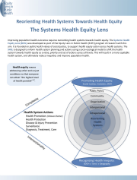 Improving population health outcomes requires reorienting health systems towards health equity. The Systems Health Equity Lens (SHEL) was developed with this goal. The SHEL is founded on public health values of social justice, to support health equity action across health systems. It is designed to inform health system planning and actions using a socio-ecological model to shift the health system towards health equity as a value, priority and set of actions across all levels. The SHEL prioritizes systematic patterns of disadvantage; differences in power and privilege; and the importance of social inclusion and representation.
Improving population health outcomes requires reorienting health systems towards health equity. The Systems Health Equity Lens (SHEL) was developed with this goal. The SHEL is founded on public health values of social justice, to support health equity action across health systems. It is designed to inform health system planning and actions using a socio-ecological model to shift the health system towards health equity as a value, priority and set of actions across all levels. The SHEL prioritizes systematic patterns of disadvantage; differences in power and privilege; and the importance of social inclusion and representation.
Health Equity Tools: It’s Not Just the Tool that Matters
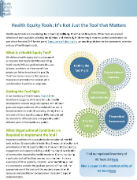 Health equity tools are one strategy for promoting health equity within health systems. While there are a broad selection of tools available, selecting the right tool and effectively implementing it requires careful consideration. Our "Health Equity Tools: It's Not Just the Tool that Matters" resource provides guidelines for the assessment, selection and use of health equity tools.
Health equity tools are one strategy for promoting health equity within health systems. While there are a broad selection of tools available, selecting the right tool and effectively implementing it requires careful consideration. Our "Health Equity Tools: It's Not Just the Tool that Matters" resource provides guidelines for the assessment, selection and use of health equity tools.
Making Health Equity a Priority
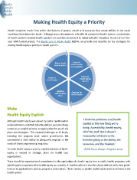 Health inequities result from unfair distributions of power, wealth and resources that create deficits in the social conditions that determine health. Although many determinants of health lie outside the health system, reorientation of health systems towards health equity is an essential component to reducing health inequities. In this resource, "Making Health Equity a Priority", we provide and describe six key strategies for making health equity a priority in health systems.
Health inequities result from unfair distributions of power, wealth and resources that create deficits in the social conditions that determine health. Although many determinants of health lie outside the health system, reorientation of health systems towards health equity is an essential component to reducing health inequities. In this resource, "Making Health Equity a Priority", we provide and describe six key strategies for making health equity a priority in health systems.
The 5 Building Blocks for Equity in Collective Impact
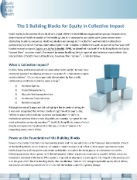 Health equity does not emerge intrinsically from well-intended multisectoral partnerships, but rather must be systematically prioritized throughout collaborative work. Collective Impact (CI) is a structured approach to aligning actions across sectors for solutions to complex social problems. As part of one of our ELPH internships, we identified that Scott’s Five Building Blocks for Equity-Focused Work provides a useful framework to ensure health equity is integrated into Collective Impact efforts. Our interpretation of Scott’s Five Building Blocks, based on other readings, is outline in our third KTE resource.
Health equity does not emerge intrinsically from well-intended multisectoral partnerships, but rather must be systematically prioritized throughout collaborative work. Collective Impact (CI) is a structured approach to aligning actions across sectors for solutions to complex social problems. As part of one of our ELPH internships, we identified that Scott’s Five Building Blocks for Equity-Focused Work provides a useful framework to ensure health equity is integrated into Collective Impact efforts. Our interpretation of Scott’s Five Building Blocks, based on other readings, is outline in our third KTE resource.
Health Equity Metaphors for Effective Communication
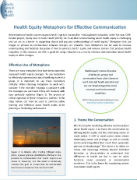 Communicating about health equity can be challenging and can act as a barrier to supporting shared and accurate understandings of health equity.1 Metaphors that use images or phrases to communicate complex concepts are powerful tools. Metaphors can be used to increase understanding and facilitate discussion of how to promote health equity and remove barriers that produce health inequities. In this resource, “Health Equity Metaphors for Effective Communication”, we offer a guide for using metaphors as a tool to enhance communication about health equity to and offer strategies for critically exploring complex health equity concepts.
Communicating about health equity can be challenging and can act as a barrier to supporting shared and accurate understandings of health equity.1 Metaphors that use images or phrases to communicate complex concepts are powerful tools. Metaphors can be used to increase understanding and facilitate discussion of how to promote health equity and remove barriers that produce health inequities. In this resource, “Health Equity Metaphors for Effective Communication”, we offer a guide for using metaphors as a tool to enhance communication about health equity to and offer strategies for critically exploring complex health equity concepts.
How is a Health Equity Lens Being Applied in BC?
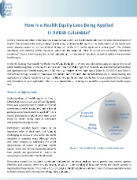 In BC, public health providers are advised to apply an equity lens to all public health programs. In the ELPH program of research, we examined understandings and application of a health equity lens in BC health authorities at two time points (Time 1: 2013/2014 and Time 2: 2015/2016) through a series of interviews with health authority staff. In this resource, “How is a Health Equity Lens Being Applied in British Columbia?”, we provide findings on the distinct differences in understanding and application of a health equity lens at each of these time points. Critical analysis of the strengths and limitations of each application informs recommendations, including the need for a systems level health equity lens.
In BC, public health providers are advised to apply an equity lens to all public health programs. In the ELPH program of research, we examined understandings and application of a health equity lens in BC health authorities at two time points (Time 1: 2013/2014 and Time 2: 2015/2016) through a series of interviews with health authority staff. In this resource, “How is a Health Equity Lens Being Applied in British Columbia?”, we provide findings on the distinct differences in understanding and application of a health equity lens at each of these time points. Critical analysis of the strengths and limitations of each application informs recommendations, including the need for a systems level health equity lens.
